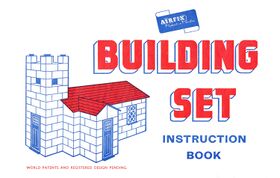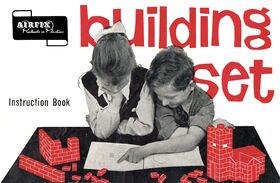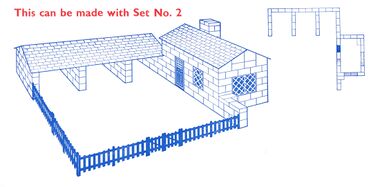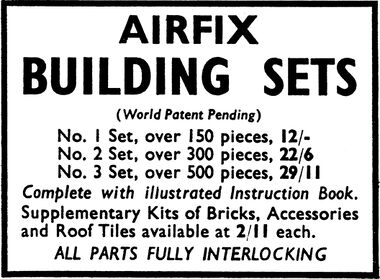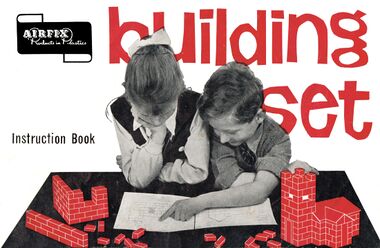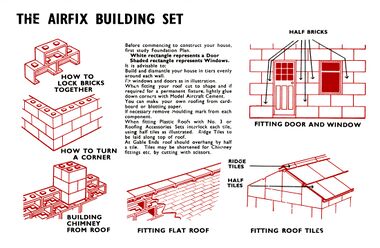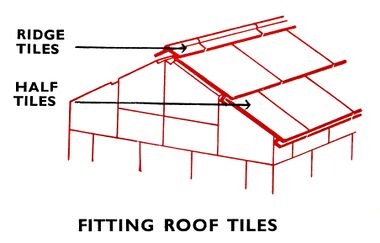Category:Airfix Building Sets
| Toy Brands and Manufacturers |
|---|
Airfix Building Sets |
| Airfix Building Set |
| 1957 - 1961 |
1955: patent application drawing. Might this have inspired the 1970s "Space Invaders" arcade graphics? [image info]
~1957: "HOW TO LOCK BRICKS TOGETHER" [image info]
~1957?: Cover of a very early red-and-blue-ink Instruction Book, listing only two accessory packs, and with no mention of a Set No.3 or a clip-together plastic roofing system. Given that these refinements appeared very quickly, we think this is probably the first version of the instruction book. [image info]
~1957: Instructions page. Note the diamond-pattern windows. [image info]
~1957: Farmyard design, for the No.2 set (cardboard roofing) [image info]
1959: Advert for sets 1-3 and accessories [image info]
~1959: The revised Instruction Book with new logo art, red and black ink [image info]
~1959: Revised instructions page, including instructions for the new plastic roof system (set No.3) [image info]
~1959: Fitting the roof tiles [image info]
~1959: Industria building using the new roof tiles [image info]
~1959: Factory building using the new roof tiles [image info]
The uninspiredly-named Airfix Building Set system (Lockbricks) was devised to get in on the clip-together plastic building brick market pioneered by Kiddicraft and Lego, but was legitimately designed along different principles. Where Kiddicraft/Lego blocks had round pegs with open bases that fitted together with a "clip-fit", the Airfix Building Sets had "lockbricks" with square pegs that tapered at around 30 degrees towards their base, a completely open back, and a semi-open base with a tapered "skirt" that engaged with the pegs, to produce a dovetail joint.
The blocks were then fitted together by sliding them into place, sideways, so that they locked into place. This meant that building a complete model involved a certain amount of advance planning and ingenuity – the target site for a block had to have a free space to one side for the block to be slid into position from.
The system appeared some time around ~1957, and was replaced in Airfix range by Betta Bilda] in around ~1961.
Design issues
The blocks, made of a modern Bakelite-style material, were remarkably inflexible, and while Airfix did an incredible engineering job in creating the pieces with "interference-fit" accuracy so that they always went together – arguably to the point of over-engineering – getting the blocks apart again afterwards could be difficult, especially if there was any dust trapped in the joints. We found with our experiments with an old sets that while it was possible to push-fit blocks together to make a perfect join, separating them again sometimes required a table edge and a hammer!
With hindsight one of the problems with the Lockbricks system was the use of multiple parallel faces sliding past each other, with sharp corners sliding through sharp gaps. This gave zero room for error, which meant that all it took was one tiny speck of sharp dust/sand to get into the joint, and sliding action would cause it to embed into the two surfaces, locking them together. The dovetail system originated in woodworking as a way of making permanent joints (often with the help of a hammer), and didn't translate so well to the needs of a reusable plastic building toy. What would have worked better would have been a slight rounding of the sharp corners to create voids in the final joint, and probably also a tapering of the pegs, or some other way of reducing the contact area and providing spaces for any displaced dust to be swept into.
Since Hilary Page's Kiddicraft system (and [[Lego]) had shown that all that was needed for a friction fit was a cylindrical peg against a flat surface, with a single line of contact, the Lockbrick system could' have used circular-cross-section tapering pegs and had the blocks fit together more easily.
Origin
The "Lockbrick" block system used for the walls seems to have been invented by an Ehrmann Mathias and patented by Nikocraft Ltd. of Aldine House, 10-13 Bedford Street, Strand, London WC2.
Branding
Airfix don't seem to have bothered to come up with any special branding for the sets, other than calling them "Building Set" and numbering them, and adding the Airfix name. This is odd, since the "Lockbricks" name was used on the accessory packs for spare bricks. "Lockbricks" was a far more memorable name and described what the bricks did, so perhaps Airfix understood the design problems with the system, or thought that Lockbricks described the limitations of the bricks too well, or perhaps they considered this to be a temporary system until something better came along, and were content to label the sets semi-generically. Did they own the system outright? If not, perhaps they might not have wanted to promote a specific product name like Lockbricks that might have ended up being sold by someone else.
First generation (~1957?)
We have two versions of the Airfix Building Set Instruction Book: an earlier booklet printed with blue ink and red highlights, and a later version with red and black ink, and a cover featuring a photographic image of two children playing with the system.
For the earlier version, roofing is entirely cardboard, and it is also suggested that "You can make your own roofing from cardboard or blotting paper". Low-profile coping stone blocks can be fitted to the top of a wall, with the edge of a card roof wedged underneath.
Two sets are mentioned (No.1 and No.2), and the back cover shows two poly-bagged accessory packs ("Airfix Additions"), "Building Accessories" and "Lockbricks". Windows have a diamond pattern, to suggest leaded glass.
Second generation (~1958)
For the later manual, set numbering goes up to No.3, the newer plastic roof tiles have now appeared (apparently only for set No.3, sets No.1 and No.2 still have cardboard roofs), windows now have simple rectangular openings rather than the previous diamond-pattern, and there is now a range of four polybagged accessory packs.
This full range is pictured in the Hobbies Annual for 1958, but still showing the same styling for the boxes and manual as for our copy of the "blue and red" "first-generation" manual, and still the diamond-pattern windows.
For convenience, we're treating the later redesigned "black and red" manual, with the same range but new styling, as being circa ~1959 (the 1958 annual does have a listing, but no photographs). It's possible, though, that more than one revision might have happened in the same year.
Roofing system
The green roof tiles seem to have come in three basic types - a full tile, a half tile and the full-and half-length roof "spine" pieces. The tiles each had one side with a thicker lower edge with a groove which allowed it to mate with other tiles, although trimming some of any protruding moulding artefacts was advisable. This allowed one to build up a simple rectangular roof panel that could be carefully laid on the top of a building. The angled blocks used under the roof at each side of the building had small small cutouts to hold the shape of the irregular lower side of a roof panel and stop it sliding off, and if two roof panels were used, the "spine" pieces could then be laid resting along the top (held only by gravity, and without actually clipping to anything or to each other) to finish the building.
Our No.3 set also includes half ridge tiles, which are also shown in the diagrams ... but we don't currently know if these were manufactured as half-size tiles, or whether the user was supposed to cut them down themselves.
The new roof system did have some restrictions in that it was only designed for rectangular roof panels supported on both sides, unlike the cardboard roofs in sets No.1 and No.2, which could be cut to produce more complex roofs with elements that intersected at 90 degrees. The No.3 manual does suggest that the plastic roof pieces could be cut with scissors (!) to accommodate chimneys, but the system had some inherent limitations that were difficult to work around.
Roofing system issues
The inexplicable thing about the roofing system is that the spine tiles don't have grooves or channels to allow them to clip to a roof panel section. In theory, one can clip the panels to the spine tiles ... but when one looks at the finished roof, it turns out that the tile overlays then point in the wrong direction, so that instead of water running down over the overlapped tiles, it would catch in a series of channels and run in between them (we accidentally built an Airfix Building Set roof like this before having a "doh" moment and realising the problem).
We're assuming that this was a design oversight – perhaps the original design had grooves for the spine tiles, and then a colleague of the designer circa 1956 helpfully suggested, "Why don't you simplify things by leaving out the groove, and simply clip the roof panels on the other way" ... and perhaps nobody realised the problem until after all the tooling was finalised and they tried building roofs out of the resulting pieces.
Whatever the explanation, it was never fixed – a few years later the whole system was replaced by Airfix Betta Bilda, which used a different roof tile system.
Hints and tips
While the Airfix Building Sets could be difficult to put together (often requiring the use of a flat table surface and light repeated taps with a hammer), taking them apart was sometimes impossible without breaking the nubs off some of the bricks ... and since the bricks usually required a pair of nubs to attach to, a brick with a missing nub had limited use.
After getting frustrated with pieces of brick pinging across the room, we've had some success with using scaldingly hot water to make the bricks come apart more easily, so from now on, any disassembly is going to involve a trip the the museum kitchen and use of the kettle.
Main Sets:
We know of three main "Airfix Building Set" sets, No.1-3, and a range of accessory sets.
Accessory sets:
- Lockbricks
- 36 × Large Bricks, 9 × Small Bricks
- Roof Accessories
- 28 × Tiles, 8 × Half Tiles, 9 × Ridge Tiles
- Garage Conversion Set
- 2 × Shop or Picture Windows, 2 × Bay Windows, 2 × Shop or French Doors, 1 × Garage Door, 1 × Garage Door Frame, 8 × Large Bricks
- Building Accessories
- 3 × Small Windows, 2 × Large Windows, 1 × Front Door, 1 × Back Door, 2 × Fences, 1 × Gate, 2 × Large Coping Stones, 2 × Medium Coping Stones, 2 × Small Coping Stones, 8 × Gable End Bricks
The end of the Airfix Building Set system
Although the Airfix Building Sets range included a range of specialised parts for including architectural details such as fences, the system lacked the spontaneity of Lego, with the designer's attitude revealed by the suggestion that builders might like to make their creations permanent with model aircraft adhesive. If one wanted to make permanent model railway buildings there were a number of good card and plastic building kits with more detail (such as the Airfix Trackside Series), whereas if one wanted a building set for play, the Lego system invited one to pull models apart and put them together again on a whim, more easily.
The people at Airfix seem to have decided that what people really wanted was Lego, and replaced the Airfix Building Set system with a more obvious Lego "clone", BettaBilda, which combined Lego-style bricks with a more sophisticated roofing system.
External links
- Airfix Building Set (architoys.net)
- Patent GB845986 (A) - Improvements in or relating to constructional toys - 1960-08-24 (from 1955/1956) (espacenet.com)
See also:
- Airfix BettaBilda – the "betta" Airfix construction system that replaced Lockbricks.
Pages in category ‘Airfix Building Sets’
The following 4 pages are in this category, out of 4 total.
Media in category ‘Airfix Building Sets’
The following 14 files are in this category, out of 14 total.
- Accessory packs, Airfix Building Sets (AirfixBSIB ~1959).jpg 2,085 × 1,466; 1.45 MB
- Airfix Building Set Instruction Book, cover, early (AirfixBSIB ~1957).jpg 3,000 × 1,903; 1.7 MB
- Airfix Building Set, Instruction Book, (AirfixBSIB ~1959).jpg 2,200 × 1,436; 1.85 MB
- Airfix Building Sets (Hobbies 1959).jpg 1,406 × 1,031; 412 KB
- Airfix Construction Kits (Hobbies 1958).jpg 1,219 × 1,600; 811 KB
- Building Accessories and Lockbricks packs, for Airfix Building Sets (AirfixBSIB ~1957).jpg 1,600 × 1,117; 1.24 MB
- Factory Building with plastic roof, Airfix Building Set No3 (AirfixBSIB ~1959).jpg 3,000 × 1,370; 1.41 MB
- Farmyard, Airfix Building Sets (AirfixBSIB ~1957).jpg 2,200 × 1,083; 726 KB
- Fitting Roof Tiles (AirfixBSIB ~1959).jpg 1,808 × 1,156; 395 KB
- How To Lock Bricks Together (AirfixBSIB ~1957).jpg 1,573 × 732; 279 KB
- Industrial buildings with plastic roof, Airfix Building Set No3 (AirfixBSIB ~1959).jpg 3,000 × 1,229; 1.36 MB
- Instructions page, Airfix Building Set (AirfixBSIB ~1957).jpg 2,200 × 1,325; 1,003 KB
- Instructions page, Airfix Building Set (AirfixBSIB ~1959).jpg 2,200 × 1,433; 1.14 MB
- Lockbricks concept drawing (Patent GB845986).jpg 1,105 × 878; 110 KB
